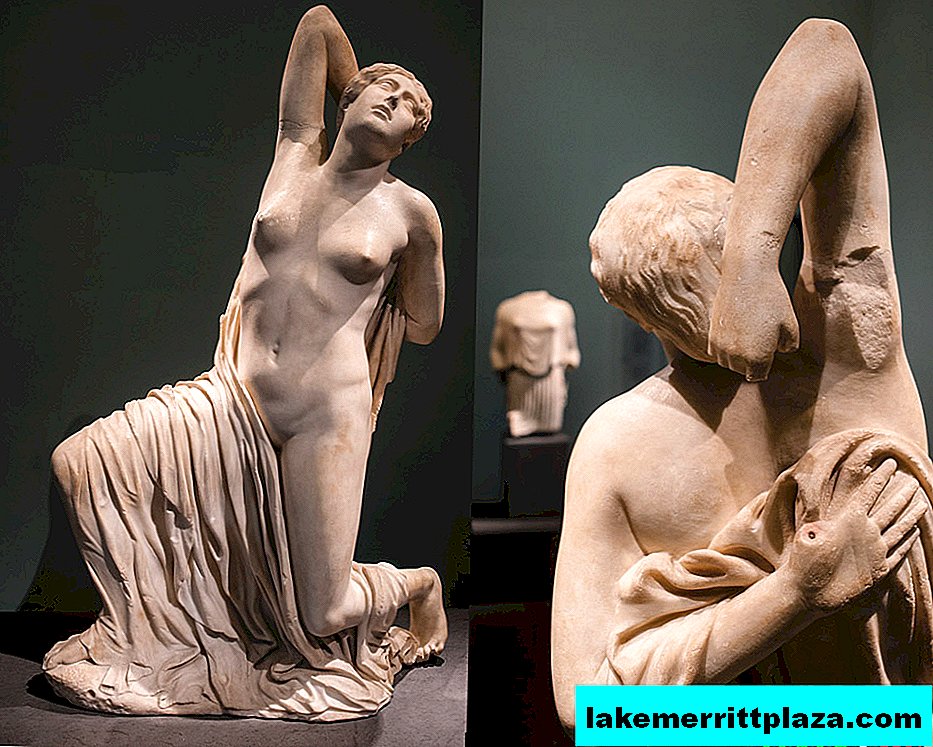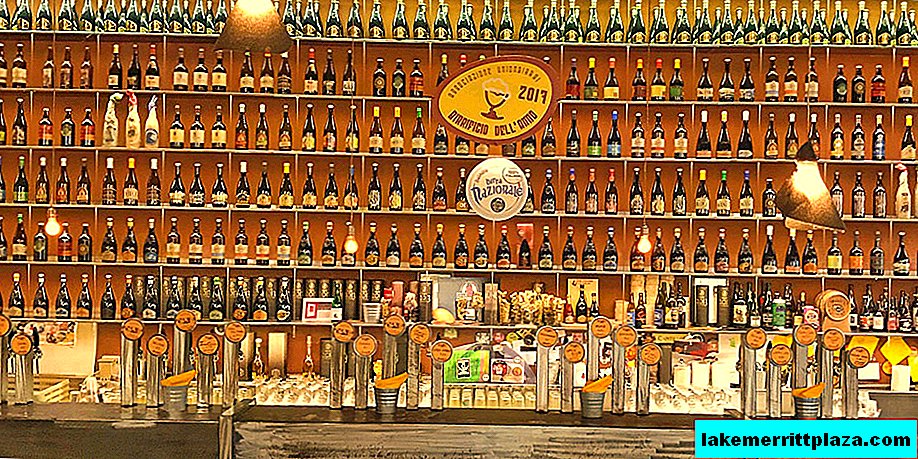Strict and at the same time solemn Palazzo Massimo (Palazzo Massimo alle Terme), located in the heart of Rome. The once luxurious mansion belonged to the family of Pope Sixtus V, and over the past decades has turned into one of the buildings of the National Museum of Rome (Museo Nazionale Romano). The walls of the palace have an impressive collection of classical art.
Story
Felice Peretti di Montalto (Felice Peretti di Montalto) better known in the history of Italy, as Sixtus V, served as pope for several years at the end of the XVI century. A native of the Italo-Serbian family has come a long way from a poor minister at the Catholic Church to a high official and diplomat. Pope managed to do a lot for the country and started an extensive reconstruction in Rome. Among the new buildings, a family mansion appeared on the map of the capital - Villa Peretti.
In 1888, the historic building was destroyed during the grand construction of the railway and Termini Station (Stazione Termini). The modern building was rebuilt with the money of the Princes Massimo in the 19th century. The architectural curator of the project was the hereditary sculptor Camillo Pistrucci, who created a wonderful example of neo-renaissance.
Until 1960, the College of the Jesuit Order met in the palace until the building became the property of the city. After reconstruction in 1998, the Museum of the Archaeological Heritage of Rome opened in the Palazzo Massimo, filled with antique sculpture, frescoes, impressive jewelry and numismatic collections.
Expositions
From the basement to the roof, Massimo's palace is filled with astounding pieces of art. Each floor is a sector dedicated to a certain subject: Paintings and mosaics, Greek art, Statues, Coins and jewelry, frescoes and interiors of wealthy Romans.
Ground floor
The first floor of the mansion contains an extensive exposition of ancient Greek and Roman art found during excavations. Exhibits of this sector demonstrate the evolution of the works of masters of ancient Greece, as well as the desire of Roman sculptors to follow the high standards established in ancient times.

Ancient sculptures are striking in their realistic execution. The figure of the “Resting Boxer” (il Pugile in riposo) is intertwined with tight muscles, and his posture and facial expression indicate extreme fatigue. The bronze statue of the "Hellenic Prince" (il Principe ellenistico) froze in an unfinished step.

Dying Niobide (Niobide morente)

The white marble sculpture depicts a mortally wounded girl who is about to fall to her knees. The unfortunate hands are twisted behind her back in a futile attempt to pull out a deadly shell. The heroine of this tragic scene is Niobid (lat. Niobid), one of the seven daughters of the mythical queen Niobe (lat. Niobe). The vain ruler defied another powerful lady - the daughter of the titan Leto (lat. Leto). The offspring of Summer - Apollo (other Greek Ἀπόλλων) and Artemis (other Greek Ἄρτεμις) took revenge on the proud Niobia, killing all her children.
According to ancient sources, the statue of the dying Niobida in the 5th century BC was part of the decoration of the temple to Apollo in the great Greek polis Eretria (other Greek Ερέτρια). Under the emperor Augustus (lat. Octavianus Augustus), this sculpture was in Rome to decorate the temple of Apollo, built by the Roman ruler.
High Priest Augusto (Augusto Pontefice Massimo)

An interesting example of Roman sculpture, personifying the emperor Augustus as Pontifex Maximus (lat. Pontifex Maximus), the high priest. The marble ruler is clothed in a toga, the folds of which very naturally tend to land. The man’s head is covered, which was part of the ritual of sacrifice. The hands of the statue are absent, but there are suggestions that in one of them was a sacrificial cup, and in the other a sacred scroll.
The face is made in sufficient detail, the cheeks and nose are well designed, wrinkles and folds are expertly drawn on the forehead and around the nose. These are the characteristic features for the sculpture of August times: realism and high performance technique. It is believed that this exhibit was created after 12 CE, that is, after the assignment to Augustus of the title of high priest.
Second floor
On this floor there are masterpieces exposed in stone and bronze - ancient statues. The most notable of the exhibits: Discobolus, Autumn Maiden, Sleeping Hermaphrodite and the black pearl of this collection are the posthumous sarcophagus from Portonachcho cemetery.
Discobolus (Il Discobolo)

"Discus thrower" is one of the most popular antique sculptures, which has been repeatedly used as a symbol of sporting events. The original statue was executed in bronze in 450 BC. architect Miron (Myron) and is considered lost. Two of her most sophisticated copies of the 2nd century AD have survived. One of them is made by the master Lancelotti (Lancelotti). Even in bygone times, "Diskobol" was considered the standard image of a person in motion.

The statue, exhibited in the Palazzo Massimo, was discovered in 1871 during excavations on Equilino Hill in Rome (lat. Mons Esquilinus). It is well preserved, unlike the second copy, which lost its head. In the 20th century, Discobol suffered another shock; it was expropriated by Germany in order to return to its homeland in 1948.
Sarcophagus of Portonaccio (Il sarcofago di Portonaccio)

The four parts of the sarcophagus from Portonaccio make an incredible impression. Marble panels are covered with a convex pattern, completely consisting of battle scenes. The extreme study of every detail simply takes away speech and hypnotizes. Dozens of warriors brought their weapons in an endless battle. In the center of the composition is the Roman commander, hurrying to defeat the enemies.

Bloody scenes are framed by four carved heads of captive barbarians. The expression of hopelessness and grief overshadows their faces, which symbolizes the ruthlessness of Rome in relation to its opponents. The side panels of the sarcophagus illustrate the dark future of the captives - shackled barbarians cross the river, and the leaders who submit to the Roman messengers.

The decor of the sarcophagus is quite characteristic, therefore, scientists have suggested that this exhibit dates back to 180 AD On the top edge of the lid of the sarcophagus are inscribed military insignia: an eagle and a wild boar. Thanks to which it was possible to establish that the sarcophagus was intended for the burial of Aulus Pompilius (lat.Aulus Pompilius), close to the emperor Marcus Aurelius (Marcus Aurelius).
Sleeping Hermaphrodite (l'Ermafrodito dormiente)

The Sleeping Hermaphrodite is an impressive tandem of ancient and medieval sculpture. The marble statue picturesquely depicts the rest of the son of Aphrodite and Hermes - the first androgyne on Earth, Hermaphrodite.

In the XVII century, Gian Lorenzo Bernini (Gian Lorenzo Bernini) was so imbued with the work of an unknown master that he supplemented the statue with a marble bed. For a long time, the updated sculpture was in the collection of the powerful cardinal Scipione Borghese.
Third floor
The third floor is reserved for the demonstration of frescoes, mosaic work, inlays.

Of particular value are the frescoes that adorned the dining room of the ancient Roman villa of Libya (Villa di Livia). The mansion belonging to the wife of Emperor Augustus was decorated with a cycle of frescoes depicting a garden. Libya's triclinium was painted with huge paintings of flowers and trees. The frescoes reached a height of 2.7 m and a width of 11.7 m.
Mosaics from Villa Farnesina were moved from Trastevere to the center of Rome without much damage. And now the museum exhibits an impeccable example of the interior decoration of a rich Roman estate.
The bright colors of contemporary art objects contrast with antique mosaics dating from the last centuries BC. - the first centuries AD The image of gods and goddesses, mythical creatures and battles, all this is done mainly in two colors - black and white. Other colors fade into the background, have a lower intensity.

It is also worth paying attention to the inlay, which previously adorned the Basilica of Junius Basso (Basilica di Giunio Basso). The piecework of an unknown master is dated to the 3rd century AD. Expensive materials and incredibly painstaking work resulted in an illustration of the travel of the Argonauts.
Basement
The underground floor of the palace is turned into a treasury, the main exhibits of which are coins and jewelry.

The numismatic collection includes extensive collections of coins that were proud of: the first king of the united Italy, Victor Emmanuel II, and the landscape painter Francesco Gnecchi.
A special reverence is caused by a set of four arrowheads, three copies and three scepters that make up the regalia of the Roman emperors. There was a place for the gold jewelry of ancient fashionistas: rings, bracelets, necklaces and hairpins.
The whole picture is complemented by the mummy of an 8-year-old girl, stored in a sarcophagus along with jewelry and a porcelain doll.
Address and time
Massimo Palace is conveniently located near Termini Train Station, which can be easily reached by metro lines A and B (Termini Station, Republic). Address: Villa Peretti (Largo Villa Peretti).
- Official site: www.archeoroma.beniculturali.it/en/node/482
- Ticket Reservation: www.coopculture.it
- Schedule: from Tuesday to Sunday, from 9:00 to 19:45. For Christmas and New Year - from 9:00 to 17:00;
- Full ticket costs: 7 euros, in case of booking through the site - an additional 2 euros from above
- Free admission: the first Sunday of the month, reservation for these days is not possible, live queue.








